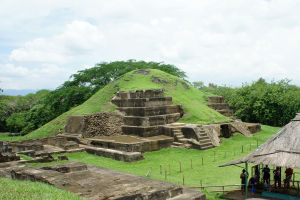
NAGOYA UNIVERSITY—Nagoya, Japan—Across the centuries, forming cooperative networks beyond cultural boundaries has been a way to overcome natural disasters.
A Nagoya University researcher and his leading international research group discovered a Great Platform built with different kinds of stone at the archeological site of San Andrés, El Salvador, and challenged the prevailing theory regarding the sociocultural development of Southeastern Maya frontier.
San Andrés is located in the Zapotitan Valley, El Salvador, known as the Southeastern Maya zone. Archaeological investigation conducted during the 40’s and 90’s has shown that San Andrés had long human occupation beginning from the Middle Preclassic (ca. 600 BC) until the Early Postclassic (ca. AD 1200), in which it had a role as a political, economic and religious center during the Late Classic period (AD 600-900). As San Andrés has been affected by numerous explosive eruptions—at least three or four—during the past two millennia, archaeologists have been interested in understanding the role of volcanic eruptions in human history.
Between February and May of 2016, the research group led by Assistant Prof. Akira Ichikawa of the Institute for Advanced Research and at the Graduate School of Letters, Nagoya University, made a new discovery that allowed them to reconsider the recovery process from the volcanic eruption of Ilopango (ca. AD 400-450), which was one of the greatest Holocene eruptions in Central America. “We have discovered a masonry platform just above the ash caused by the Ilopango eruption in San Andrés, which could prove that people reoccupied in such a devastated area even immediately after the enormous disaster occurred,” said Ichikawa.
He noted that the discovery of masonry architecture (a 4-tiered platform, measuring probably ca. 70 m north-south, 60 m east-west, and ca. 6 m) was conclusive in this study. In the Southeastern Maya periphery, especially present western El Salvador, monumental architecture had been principally constructed by earthen material during the Preclassic to Classic period (ca. 800 BC to AD 900). The type of platform mentioned above is very similar to that of Quelepa located in present-day eastern El Salvador and had other cultural affiliations in the Precolumbian era. This evidence indicates that San Andrés’s new construction technology was introduced by an external cultural connection.
________________________________________
Mayan pyramid at La Acropolis, San Andres, El Salvador (structure 1) Mariordo, Wikimedia Commons
_____________________________________________________
Topographic map of the Structure-5 of San Andrés site showing the excavation area with pictures of masonry architecture under the earthen architecture. Credit: Akira Ichikawa and Juan Manuel Guerra
__________________________________________________
Ichikawa speculated that the social group that lived in the Quelepa may have given a hand to help the people in the fully devastated Zapotitan Valley soon after a volcanic eruption occurred. Since the Great Platform found in this study could be considered monumental architecture to commemorate the people in the affected area, people in these areas must have had some cooperative relations beyond their cultural boundaries.
San Andrés has been investigated in terms of its relations mainly with Copán, the representative Classic Maya center located in western Honduras. “In this study we opened the gate by broadening our perspectives to the peripheral border beyond the cultural boundaries,” Ichikawa added. He expects that an understanding of the cultural development in peripheral areas will reveal the historical dynamism across multicultural societies.
Source: Edited from the subject Nagoya University news release.
_____________________________________________________

______________________________________________
Travel and learn with Far Horizons.
____________________________________________
This richly illustrated issue includes the following stories: Recent findings shedding new light on the whereabouts of the remains of Philip of Macedon, father of Alexander the Great; how an archaeologist-sculptor is bringing bones of the dead back to life; archaeologists uncovering town life at the dawn of civilization; an exclusive interview with internationally acclaimed archaeologist James M. Adovasio about what makes the Meadowcroft Rockshelter prominent in the ongoing search for the first Americans; what archaeologists are finding at the site of the ancient city of Gath, the home town of the biblical Philistine giant, Goliath; and how scientists are redrawing the picture of human evolution in Europe. Find it on Amazon.com.










